




OUR BEST EVER OFFER - SAVE £100/$100
JOIN THE WORLD'S LEADING PROFESSIONAL DEVELOPMENT PROGRAMME
- 12 months membership of Elite Soccer
- Print copy of Elite Player & Coach Development
- Print copy of The Training Ground
You are viewing 1 of your 1 free articles
Counter-attacking: ball work
| Area | Parts of a full pitch |
| Equipment | Balls, cones, goals |
| No. of Players | Up to 7v7 plus keepers |
| Session Time | 65mins |
Let’s face it, transitions have become vital in the modern game because when the opposition are organised defensively, it’s very difficult to score. Yet the moment an opponent loses the ball is the time to exploit the opportunity of players being out of position. So this session looks at transitions and counter-attacking with a specific focus on running with the ball.
It encourages players to attack early with numbers and pace, and embraces 1v1s, 2v1s, 2v2s, 3v2s, 3v3s and more as both underloads and overloads, progressing from unopposed technical and warm-up practices to opposed and conditioned games.
This session can work from both attacking and defensive perspectives and is one that players love - it keeps everyone involved, encourages them to make split-second decisions, is 360 degrees in giving them a taste of everything that happens on match day, as well as being very intensive and physically demanding.
What do I get the players to do?
Part 1: Technical practice (10mins)
We use 6-8 players per group in a 30x8-yard area, setting up as shown (1/2), and repeat end-to-end.
Once players are comfortable with the first stage, we alter the set-up so they can experience being put under pressure from behind.
1
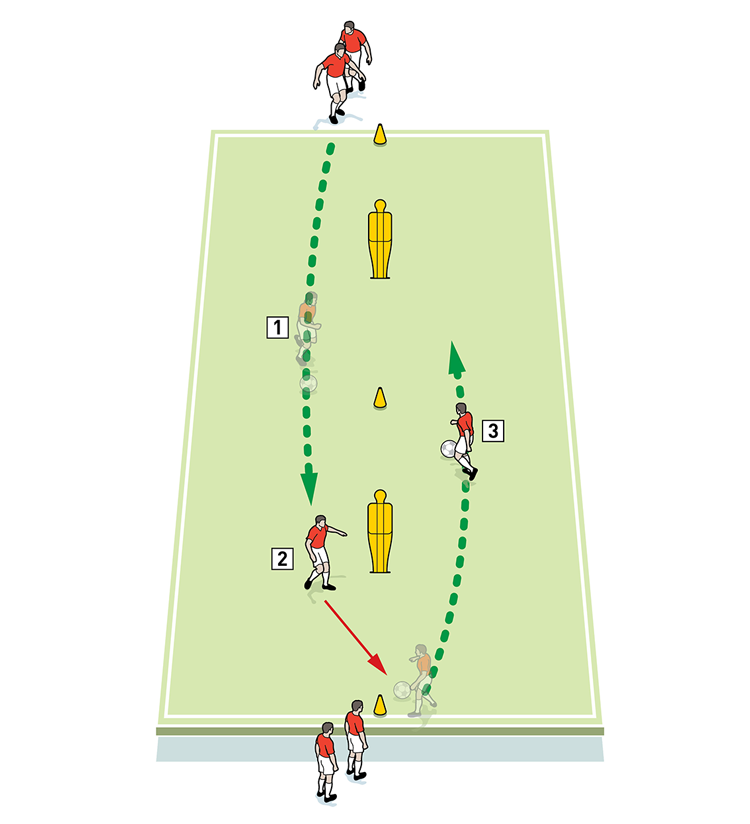
2. Once beyond the mannequin, he plays a pass with the outside of his foot to player 2
3. Player 2 receives the ball and travels back in the opposite direction to player 3
2
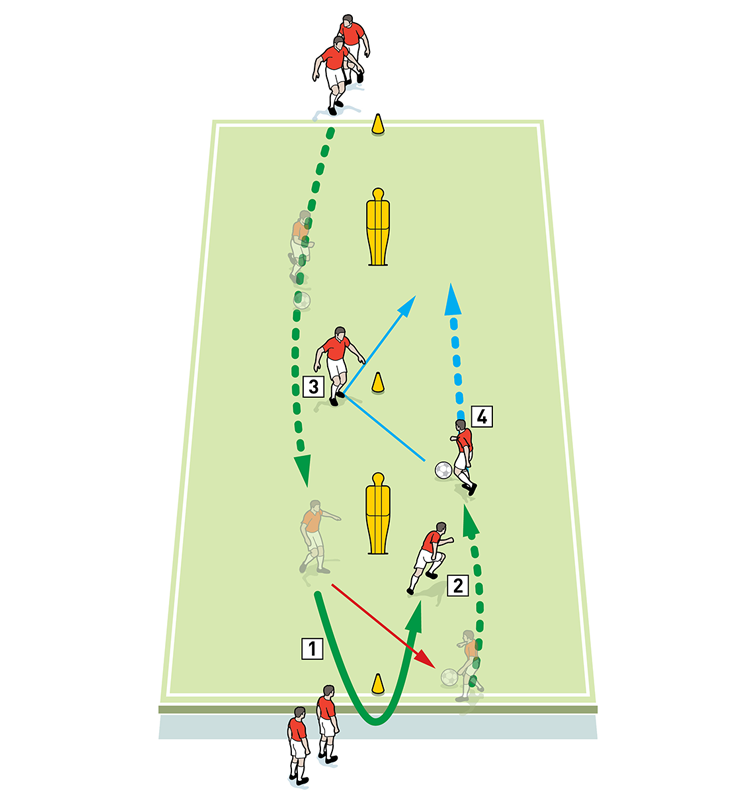
2. Once around he chases the receiving player who is now travelling with the ball towards the other end
3. We can also introduce a link-up player at the middle yellow cone
4. Here, the player makes a decision as to whether to dribble with the ball or pass to the link player
What are the key things to look out for?
We want to see the three ‘Ds’ of first-touch respected – they are direction, disguise and distance. Players running with the ball at optimal speed must be firmly in control of it, with awareness of where they are travelling (in terms of recognising where the danger, the space and the support is). Timing and execution of the pass is crucial, with good reactions a must.
Part 2: Squad wave practice (20-25mins)
We now set up in the space between the penalty areas on a narrowed pitch, as shown (3). There are two nominated strikers, with the no.9s remaining in position throughout. When one attack ends the practice switches around and comes back the other way, where two new defenders will enter the practice with the previous two recovering off the field.
3
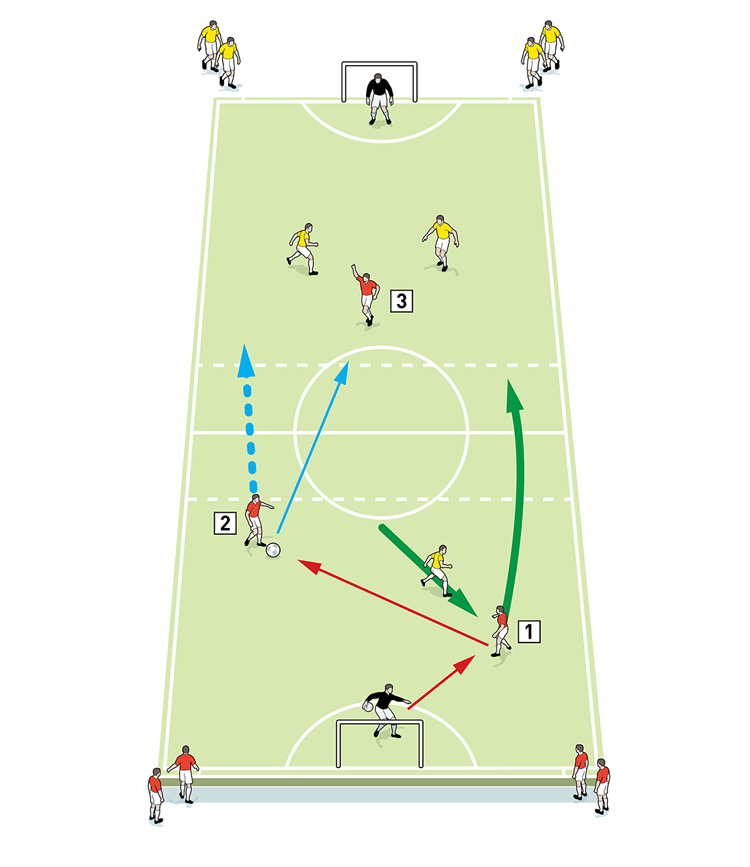
2. They play 2v1 against no.9 with the aim of running the ball through the midfield area
3. Once in the attacking area they join their own no.9 and play 3v2 to score
If defenders win the ball at any stage they launch a quick counter- attack and the practice continues from there.
As a progression, the no.9 can leave his area and assist his two defenders. We’ll also rotate the player in the no.9 role from time to time.
What are the key things to look out for?
We must see a positive attitude from all players and it’s the job of the coaches to constantly emphasise that. The keeper must learn to ‘see a bigger picture’, playing forward in ‘giving it early and quicker’. Receiving players should try to take a first touch forward where possible, looking to attack the space in front by running with the ball at speed and trying to get through the three areas quickly, with team mates displaying good movement in front of the ball. Over time, players will learn when to stay on the ball and when to pass or finish.
Part 3: Squad conditioned game (15mins)
Now it’s 8v8 with one team attacking in normal game rules (4). The other looks to counter-attack upon regaining possession and has eight seconds to score. Wherever they win the ball back influences who can defend from the opposition, because only opponents goal side of the ball at the moment of transition can defend. This condition ensures random overloads and varying start positions of counter-attacks (5). The rule also applies with restarts, especially throw-ins, and we’ll rotate team roles after a few minutes.
4
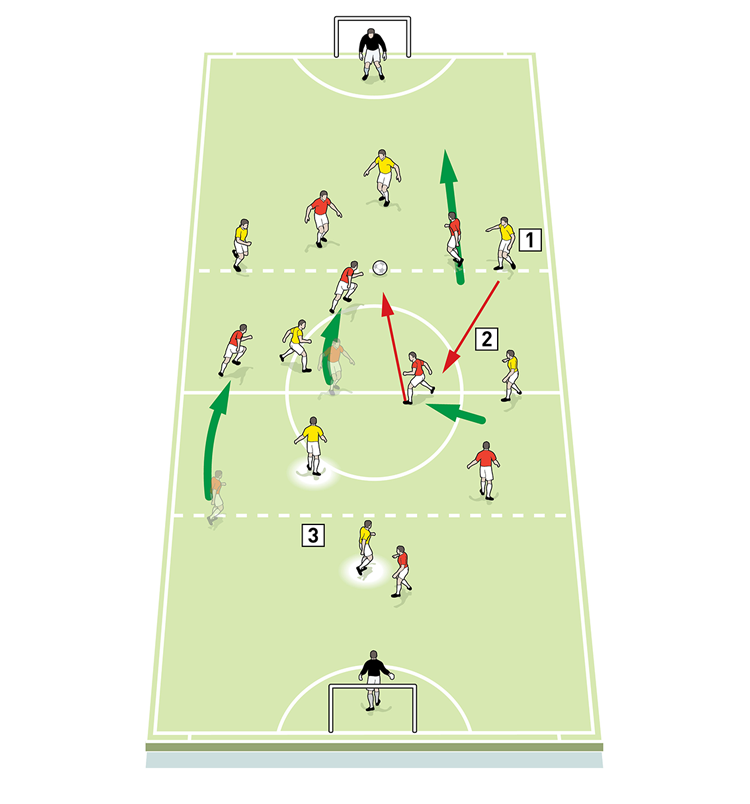
2. A forward pass is intercepted by a red midfielder
3. With the ‘goal side condition’ in place, both strikers would be out of the game and cannot defend or influence the opposition
5
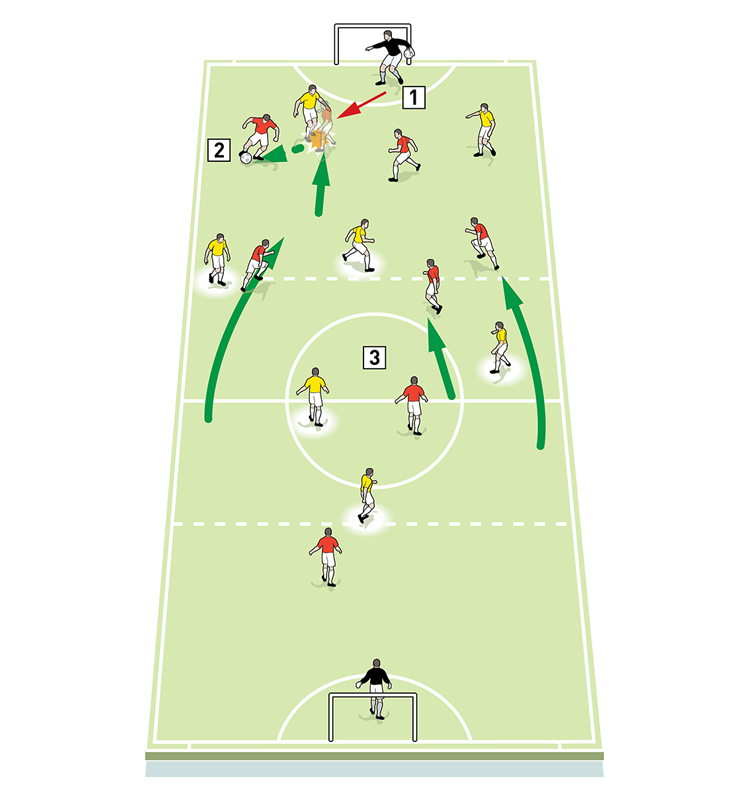
2. The red attacker makes a quick tackle
3. The reds have isolated five yellows and can play a 5v2 overload
What are the key things to look out for?
Players must organise defensively, being ready to break up play and create space quickly. They must ‘play up’, running forward with the ball in finding space, whilst closing up behind to secure the space behind the ball in case opponents counter our counter-attack. Finally we’re looking for a positive finish.
Part 4: Small-sided games (15 mins)
To conclude we play 3x4mins small-sided games as a method of the coach checking players’ understanding. These must be at high intensity, with teams encouraged to leave two players back to defend while others are readily invited to be adventurous!
Related Files
Editor's Picks
Attacking transitions
Deep runs in the final third
Using the goalkeeper in build-up play
Intensive boxes drill with goals
Penetrating the final third
Creating and finishing
My philosophy
Pressing initiation
Compact team movement
Coaches' Testimonials

Alan Pardew

Arsène Wenger

Brendan Rodgers

Carlos Carvalhal

José Mourinho

Jürgen Klopp

Pep Guardiola

Roy Hodgson

Sir Alex Ferguson

Steven Gerrard
Coaches' Testimonials

Gerald Kearney, Downtown Las Vegas Soccer Club

Paul Butler, Florida, USA

Rick Shields, Springboro, USA

Tony Green, Pierrefonds Titans, Quebec, Canada
Join the world's leading coaches and managers and discover for yourself one of the best kept secrets in coaching. No other training tool on the planet is written or read by the calibre of names you’ll find in Elite Soccer.
In a recent survey 92% of subscribers said Elite Soccer makes them more confident, 89% said it makes them a more effective coach and 91% said it makes them more inspired.
Get Monthly Inspiration
All the latest techniques and approaches
Since 2010 Elite Soccer has given subscribers exclusive insight into the training ground practices of the world’s best coaches. Published in partnership with the League Managers Association we have unparalleled access to the leading lights in the English leagues, as well as a host of international managers.
Elite Soccer exclusively features sessions written by the coaches themselves. There are no observed sessions and no sessions “in the style of”, just first-hand advice delivered direct to you from the coach.







